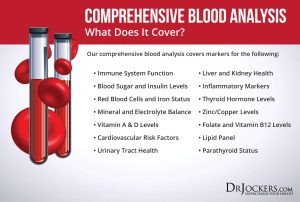Did your doctor tell you that your lab ranges are “NORMAL”?
The difference between normal blood chemistry ranges used by doctors and labs versus optimal ranges in functional medicine lies in their approach to health and disease:
1. Conventional (Normal) Ranges:
- Purpose: Identify disease or pathology.
- Derived from: A statistical average based on a broad population, including both healthy and unhealthy individuals.
- Focus: Detecting serious health conditions such as diabetes, heart disease, or liver dysfunction.
- Thresholds: Wider ranges to accommodate variations within the general population.
- Example:
- Fasting blood glucose “normal” range: 70-99 mg/dL (anything above 99 is considered prediabetic).
2. Functional (Optimal) Ranges:
- Purpose: Identify trends and imbalances before they develop into disease; focus on prevention and performance optimization.
- Derived from: Healthier subsets of the population, aiming for peak wellness rather than just the absence of disease.
- Focus: Detecting early dysfunction and promoting optimal physiological function.
- Thresholds: Narrower ranges that reflect a more finely tuned balance of health.
- Example:
- Fasting blood glucose “optimal” range: 75-85 mg/dL (values above 85 may indicate metabolic dysfunction).
Key Differences in Approach:
| Aspect | Normal Ranges (Conventional) | Optimal Ranges (Functional) |
|---|---|---|
| Focus | Disease detection | Health optimization & prevention |
| Population Basis | Average population (sick + healthy) | Healthy individuals |
| Intervention | Reactive (once disease is present) | Proactive (early intervention) |
| Range Width | Broad | Narrow and precise |
| Example Tests | Cholesterol, blood glucose, thyroid hormones | Same tests but with more detailed interpretation |
Why Functional Medicine Uses Optimal Ranges:
- To detect early imbalances (e.g., blood sugar dysregulation before diabetes develops).
- To guide lifestyle, nutrition, and supplementation for peak performance.
- To personalize health strategies based on an individual’s unique needs.
What is Apolipoprotein B (ApoB)?
- ApoB is a protein attached to cholesterol particles in the bloodstream—each cholesterol particle has one ApoB.
- ApoB testing measures the number of cholesterol-carrying particles, providing a clearer picture of heart disease risk than traditional cholesterol tests.
- More accurate than LDL-C and non-HDL-C tests, as it counts particles rather than cholesterol mass.
- Not widely adopted yet, despite its accuracy, due to cost concerns and unfamiliarity among doctors.
Why is ApoB Important?
- High ApoB levels mean more cholesterol particles, increasing the risk of plaque buildup and cardiovascular disease.
- Standard tests like LDL-C measure cholesterol concentration, which can be misleading.
- ApoB testing is recommended by some guidelines, especially for individuals with high triglycerides or existing heart disease.
How Does ApoB Work?
- Cholesterol is carried in the bloodstream by lipoproteins (VLDL, IDL, LDL, Lp[a]), all of which contain ApoB and contribute to plaque buildup.
- The ApoB test tracks all these particles, providing a better measure of heart disease risk.
- HDL (“good cholesterol”) does not contain ApoB, making the test specific to harmful particles.
Why Get an ApoB Test?
- Provides a more precise heart disease risk assessment, especially for individuals with high cholesterol or family history of heart disease.
- A large 2021 UK study confirmed that higher ApoB levels increase heart disease and stroke risk while reducing lifespan.
- Recommended alongside traditional cholesterol tests for better risk management.
How to Lower ApoB Levels
- Reduce saturated fat intake, increase fiber and Omega-3s.
- Regular aerobic exercise, with resistance training if possible.
- Consider discussing ApoB testing with your healthcare provider for a deeper insight into your cardiovascular health.
- https://www.levels.com/blog/why-apob-may-be-a-better-cholesterol-marker
- Several genetic markers influence ApoB levels, affecting cholesterol metabolism and cardiovascular disease risk. Key genetic variants associated with ApoB levels include:
1. APOB Gene (Apolipoprotein B)
- Primary gene responsible for ApoB production.
- Variants can lead to:
- Familial Hypercholesterolemia (FH):
- rs1042034 (C>T) – Associated with higher LDL cholesterol and increased cardiovascular disease risk.
- rs693 (A>G) – Linked to elevated ApoB and LDL-C levels.
- Hypobetalipoproteinemia:
- Certain mutations result in lower ApoB levels, leading to reduced cholesterol transport.
- Familial Hypercholesterolemia (FH):
2. PCSK9 Gene (Proprotein Convertase Subtilisin/Kexin Type 9)
- Regulates LDL receptor degradation, affecting LDL clearance.
- Variants:
- rs11591147 (A>G) – Linked to lower ApoB and LDL-C levels, providing cardioprotective effects.
- Gain-of-function mutations – Increase LDL-C and ApoB by reducing LDL receptor recycling.
3. LDLR Gene (Low-Density Lipoprotein Receptor)
- Influences LDL clearance from the bloodstream.
- Mutations can impair LDL uptake, leading to increased ApoB levels.
- Common variant:
- rs688 (G>A) – Associated with higher LDL-C and ApoB.
4. ANGPTL3 Gene (Angiopoietin-like 3)
- Involved in lipid metabolism by inhibiting lipoprotein lipase.
- Variants like rs11207977 can influence ApoB levels by altering triglyceride metabolism.
5. CETP Gene (Cholesteryl Ester Transfer Protein)
- Regulates the exchange of cholesterol between HDL and ApoB-containing lipoproteins.
- Variants such as rs3764261 (T>C) can lower HDL and raise ApoB levels.
6. LPL Gene (Lipoprotein Lipase)
- Breaks down triglycerides in lipoproteins.
- Variants like rs328 (C>G) impact ApoB levels by affecting lipid clearance.
7. HMGCR Gene (HMG-CoA Reductase)
- Key enzyme in cholesterol biosynthesis.
- Variants like rs3846662 (T>C) can alter cholesterol synthesis and influence ApoB levels indirectly.
8. SORT1 Gene (Sortilin 1)
- Regulates hepatic LDL secretion and clearance.
- rs646776 (C>T) – Linked to lower LDL-C and ApoB levels.
9. PPARα Gene (Peroxisome Proliferator-Activated Receptor Alpha)
- Regulates lipid metabolism and ApoB production.
- Variants can affect triglyceride levels and indirectly impact ApoB.
10. LIPA Gene (Lysosomal Acid Lipase A)
- Involved in the breakdown of cholesterol esters and triglycerides.
- Mutations may lead to lipid accumulation and increased ApoB levels.
Genetic testing for these markers can provide insight into personalized strategies for managing ApoB and cardiovascular disease risk.
